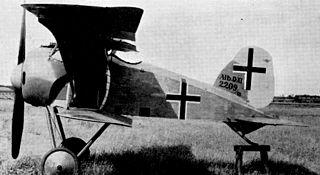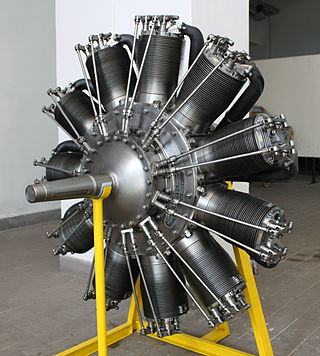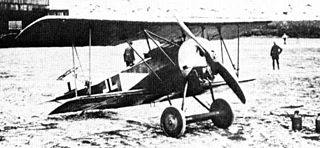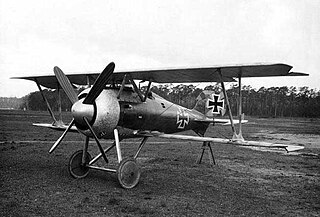
The Fokker Dr.I, often known simply as the Fokker Triplane, was a World War I fighter aircraft built by Fokker-Flugzeugwerke. The Dr.I saw widespread service in the spring of 1918. It became famous as the aircraft in which Manfred von Richthofen gained his last 17 victories, and in which he was killed on 21 April 1918.

The Focke-Wulf Fw 44 Stieglitz ("Goldfinch") is a 1930s German two-seat biplane. An early design by Kurt Tank, it was produced by the Focke-Wulf company as a pilot training and sports flying aircraft. It was also built under license in several other countries.

The Fokker E.V was a German parasol-monoplane fighter aircraft designed by Reinhold Platz and built by Fokker-Flugzeugwerke. The E.V was the last Fokker design to become operational with the Luftstreitkräfte, entering service in the last months of World War I. After several fatal accidents due to wing failures, the aircraft was modified and redesignated Fokker D.VIII. Dubbed the Flying Razor by post-war pulp-fiction writers, the D.VIII had the distinction of scoring the last aerial victory of the war.

Siemens-Schuckert was a German electrical engineering company headquartered in Berlin, Erlangen and Nuremberg that was incorporated into the Siemens AG in 1966.

The Siemens-Schuckert D.IV was a late-World War I fighter aircraft from Siemens-Schuckert (SSW). It reached service too late and was produced in too few numbers to have any effect on the war effort.

The Albatros D.XI was a German single-seat fighter sesquiplane first flown in February 1918. It was the first Albatros fighter to use a rotary engine, in the form of the 120 kW (160 hp) Siemens-Halske Sh.III, and also featured a new wing construction with diagonal struts from the fuselage replacing traditional wire bracing.

The Siemens-Halske Sh.III was an 11-cylinder, air-cooled counter rotary engine developed in Germany during World War I. The engine was a development of the earlier 9-cylinder Siemens-Halske Sh.I.
The Arado W 2 was a two-seat twin-engine seaplane trainer developed for the DVS in 1928. It was a cantilever monoplane with a fabric-covered steel tube fuselage that accommodated the pilot and instructor in tandem open cockpits. The undercarriage consisted of two pontoons carried on steel struts.

The Pfalz D.VIII was a German World War I fighter aircraft.

The Fokker D.VI was a German fighter aircraft built in limited numbers at the end of World War I. The D.VI served in the German and Austro-Hungarian air services.

The Siemens-Schuckert D.I was a single-seat fighter built by Siemens-Schuckert Werke in 1916. It was a German copy of the French Nieuport 17 that was obsolete by the time it was available in numbers, so that it served mainly as an advanced trainer.

The Siemens-Schuckert D.III was a German single-seat fighter built by Siemens-Schuckert Werke. The D.III was a development of the earlier Siemens-Schuckert D.IIc prototype. The D.III was an (nearly) equal-span biplane powered by a 160 hp (119 kW) Siemens-Halske Sh.III bi-rotary engine. Idflieg placed an order for 20 aircraft in December 1917, followed by a second order of 30 aircraft in February 1918.

The Fokker S.IV was a military trainer aircraft produced in the Netherlands in the mid-1920s. It was a conventional, single-bay biplane with staggered wings of unequal span braced with N-struts, essentially a radial-engined development of the S.III. The pilot and instructor sat in tandem, open cockpits and the undercarriage was of fixed, tailskid type with a cross-axle between the main units. The Royal Netherlands Army Aviation Group purchased 30 examples and used them right up to the German invasion of the Netherlands in 1940. On 14 May that year, a few surviving S.IVs escaped to France alongside some S.IX trainers, but never flew again.

The Pfalz Dr.I was a German fighter prototype of World War I. Official interest in the potential of the triplane configuration for single-seat fighters prompted Pfalz to develop the Dr.I. It underwent initial testing in October 1917, and an initial batch of 10 aircraft were shipped to the Front and arrived in April 1918.

The Siemens-Schuckert E.I was a German fighter aircraft, manufactured by Siemens-Schuckert.

The Siemens-Schuckert D.VI was a single engine, single seat, parasol wing German fighter aircraft flown in 1919.

The Siemens-Schuckert DDr.I was a World War I German twin engine, push-pull configuration triplane fighter aircraft. Only one was built, crashing on its first flight.

The LFG Roland D.IX was a World War I German single seat fighter aircraft, a biplane powered by one of a new generation of powerful rotary engines. Three slightly different prototypes were built but there was no series production.
The Siemens-Schuckert B was an unarmed German two seat reconnaissance biplane built early in World War I. A single example was delivered but soon lost.
The Pfalz Dr.II was a German triplane fighter prototype of World War I built by Pfalz Flugzeugwerke.

















